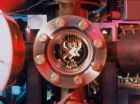(Press-News.org) ANN ARBOR, Mich. — Researchers don't know the exact cause of Behçet's disease, a chronic condition that leads to oral and genital sores and serious complications such as blindness, but new research brings better understanding to what makes some people more susceptible to being affected.
In one of the most extensive genetic analyses of Behçet's disease, a University of Michigan-led, international team of researchers has identified novel gene variants in the inflammatory disorder and uncovered data that could apply to studies of other diseases. The results appear in the journal Nature Genetics.
"This disease is associated with significant complications and because it is not well understood, treatment options are limited," says lead author Amr Sawalha, M.D., associate professor of internal medicine in the division of rheumatology at the U-M Medical School.
"We were able to identify and localize robust genetic risk factors associated with Behçet's disease in a way that will hopefully bring us a step closer to better understanding this devastating illness."
The UMHS research, a collaboration that includes researchers from Turkey, Italy, Germany and the Netherlands, identifies how a specific group of genes are linked to Behçet's disease. The disease can affect people from all ethnicities, but has an increased prevalence along the ancient "Silk Road" in East Asia, Turkey, and the Mediterranean and Middle Eastern countries.
The disorder causes chronic inflammation in blood vessels throughout the body and affects many organs, including the eyes, brain, skin, joints and the digestive system. Some symptoms may include mouth and genital ulcers, eye inflammation and reduced vision, skin rashes and lesions, joint swelling, abdominal pain and diarrhea.
Behçet's disease may also cause inflammation in the brain, which could cause headaches, fever, poor balance or stroke. Inflammation in veins and large arteries could also lead to other complications, such as aneurysms.
One of the major genetic risk factors of the disease is believed to be a specific form of a gene on chromosome 6 in the HLA region (an inherited group of genes known as human leukocyte antigen). The new study shows that contrary to the belief that genetic risk in this region is most strongly tied to a form of the gene HLA-B (called HLA-B*51) – there are actually at least four independent genetic risk regions within the HLA linked to the disease. and the risk previously attributed to the HLA-B*51 protein itself is explained by a gene variant outside the HLA-B gene. Researchers have long studied the phenomenon of why certain forms of HLA are associated with autoimmune and inflammatory disorders and the severity of those disorders.
"This HLA region has an incredibly significant role in many diseases. It's also one of the most complicated areas of the human genome, which is why it's so difficult to analyze," Sawalha says. "This is an extensive way to look at the HLA region that can be also applied to other diseases. We can now identify and localize the risks within this complex HLA region more accurately than ever before, which opens the door to further developments."
INFORMATION:
Additional authors: Travis Hughes and Patrick Coit, of U-M. Adam Adler, Vuslat Yilmaz, , Kenan Aksu, Nursen Düzgün, Gokhan Keser, , Ayse Cefle, Ayten Yazici, Andac Ergen, Erkan Alpsoy, Carlo Salvarani, Bruno Casali, Ina Kötter, Javier Gutierrez-Achury, Cisca Wijmenga, Haner Direskeneli, and Güher Saruhan-Direskeneli.
Funding: The Rheumatology Research Foundation
Disclosure: None
Reference: Nature Genetics, February, 2013, "Identification of multiple independent susceptibility loci in the HLA region in Behçet's disease," doi:10.1038/ng.2551.
Researchers uncover new findings on genetic risks of Behçet's disease
Study identifies regions of genes linked to Behçet's, a poorly understood condition that causes painful and serious symptoms, including ulcers and brain inflammation
2013-02-15
ELSE PRESS RELEASES FROM THIS DATE:
Spectacular forcepfly species discovered for the first time in South America
2013-02-15
Forcepflies are usually known as earwigflies, because the males have a large genital forceps that resembles the cerci of earwigs. A new species of forcepfly Meropeidae (Mecoptera) from Brazil was described, representing only the 3rd extant species described in this family and the 1st record of the family from the Neotropical region. The distribution and biogeography of the family are discussed and it is even proposed that Meropeidae originated before continental drift and then divided into two branches, northern and southern, with the breakup of the old supercontinent Pangea. ...
This is why it takes so long to get over tendon injuries
2013-02-15
The Achilles heel of the body – getting over damage to tendons can be a long and painful process. By combining the nuclear tests of the 1950s with tissue samples and modern technology, a research collaboration between the Aarhus University and University of Copenhagen now reveals why the healing process is so slow.
Many people are affected by injuries caused by straining the Achilles tendon and other tendons in the body. Danish athletes alone account for up to 200,000 injuries per year. This often leads to frustration over the poor treatment options available, and it can ...
Research uncovers a potential link between Parkinson's and visual problems
2013-02-15
The most common genetic cause of Parkinson's is not only responsible for the condition's distinctive movement problems but may also affect vision, according to new research by scientists at the University of York.
Parkinson's, the second most common form of neurodegenerative disease, principally affects people aged over 60. Its most common symptom is tremor and slowness of movement (bradykinesia) but some people with Parkinson's also experience changes in vision.
Now for the first time, researchers in the University's Department of Biology have established a link between ...
Playing quantum tricks with measurements
2013-02-15
This press release is available in German.
A team of physicists at the University of Innsbruck, Austria, performed an experiment that seems to contradict the foundations of quantum theory -- at first glance. The team led by Rainer Blatt reversed a quantum measurement in a prototype quantum information processor. The experiment is enabled by a technique that has been developed for quantum error correction in a future quantum computer.
Measurements on quantum systems have puzzled generations of physicists due to their counterintuitive properties. One of them is the fact ...
Can hospital readmission rates be trusted?
2013-02-15
MAYWOOD, Il. - When hospital patients have to be readmitted soon after discharge, hospitals look bad.
A high readmission rate also can result in reduced Medicare reimbursements. But a study of spine surgery patients has found that the standard method used to calculate readmission rates is a misleading indicator of hospital quality. Loyola University Medical Center neurosurgeon Beejal Amin, MD, and colleagues found that 25 percent of the readmissions of spine surgery patients were not due to true quality-of-care issues.
Results are reported in a featured article in the ...
The same genetic defect causes Pompe disease in both humans and dogs
2013-02-15
Pompe disease, a severe glycogen storage disease appearing in Lapphunds is caused by a genetic defect in acid α-glucosidase gene. The same genetic mutation also causes the equivalent disease in humans. Based on this finding, canine Pompe disease can now be diagnosed with a genetic test.
This research was completed at the Canine Genetics Research Group lead by professor Hannes Lohi in the University of Helsinki and Folkhälsan Research Center in Finland and will be published in PLOS ONE on February 14, 2013.
Human Pompe disease is caused by complete or partial deficiency ...
The discovery of a new genus of crustacean and 5 new species
2013-02-15
Experts from the Centre for Advanced Studies of Blanes and the University of Barcelona (UB) collected and studied different crustacean specimens during recent expeditions to Madagascar, New Caledonia, Vanuatu, the Philippines and French Polynesia.
Using morphological and molecular data they have discovered five new species of crustaceans in the waters of these regions. They are genetically different but morphologically very similar and they also found a new genus, named Triodonthea. The five new species documented in the study belong to the Lauriea genus of the Galatheidae ...
Force is the key to granular state-shifting
2013-02-15
Ever wonder why sand can both run through an hourglass like a liquid and be solid enough to support buildings? It's because granular materials – like sand or dirt – can change their behavior, or state. Researchers from North Carolina State University have found that the forces individual grains exert on one another are what most affect that transition.
Physicists have explored the changing behavior of granular materials by comparing it to what happens in thermodynamic systems. In a thermodynamic system, you can change the state of a material – like water – from a liquid ...
Chemists develop single molecule sieves to separate complex molecular mixtures
2013-02-15
Chemists at the University of Liverpool have created a new technique that could be used in industry to separate complex organic chemical mixtures.
Chemical feedstocks containing benzene are used extensively in industry to create modern materials and polymers. Their use relies heavily on distillation techniques which separate complex mixtures into more simple molecules used as building blocks to develop drugs, plastics and new materials. These distillation techniques can be expensive and involve large amounts of energy for hard-to-separate mixtures.
A team of researchers ...
Rutgers physicists test highly flexible organic semiconductors
2013-02-15
Organic semiconductors hold promise for making low-cost flexible electronics – conceivably video displays that bend like book pages or roll and unroll like posters, or wearable circuitry sewn into uniforms or athletic wear. Researchers have demonstrated the ability to "print" transistors made of organic crystals on flexible plastic sheets, using technology that resembles inkjet or gravure printing.
However, for the technology's potential to be realized, scientists have to show that these organic semiconductors will withstand the rugged handling they invite – they will ...
LAST 30 PRESS RELEASES:
Longest observation of an active solar region
Why nail-biting, procrastination and other self-sabotaging behaviors are rooted in survival instincts
Regional variations in mechanical properties of porcine leptomeninges
Artificial empathy in therapy and healthcare: advancements in interpersonal interaction technologies
Why some brains switch gears more efficiently than others
UVA’s Jundong Li wins ICDM’S 2025 Tao Li Award for data mining, machine learning
UVA’s low-power, high-performance computer power player Mircea Stan earns National Academy of Inventors fellowship
Not playing by the rules: USU researcher explores filamentous algae dynamics in rivers
Do our body clocks influence our risk of dementia?
Anthropologists offer new evidence of bipedalism in long-debated fossil discovery
Safer receipt paper from wood
Dosage-sensitive genes suggest no whole-genome duplications in ancestral angiosperm
First ancient human herpesvirus genomes document their deep history with humans
Why Some Bacteria Survive Antibiotics and How to Stop Them - New study reveals that bacteria can survive antibiotic treatment through two fundamentally different “shutdown modes”
UCLA study links scar healing to dangerous placenta condition
CHANGE-seq-BE finds off-target changes in the genome from base editors
The Journal of Nuclear Medicine Ahead-of-Print Tip Sheet: January 2, 2026
Delayed or absent first dose of measles, mumps, and rubella vaccination
Trends in US preterm birth rates by household income and race and ethnicity
Study identifies potential biomarker linked to progression and brain inflammation in multiple sclerosis
Many mothers in Norway do not show up for postnatal check-ups
Researchers want to find out why quick clay is so unstable
Superradiant spins show teamwork at the quantum scale
Cleveland Clinic Research links tumor bacteria to immunotherapy resistance in head and neck cancer
First Editorial of 2026: Resisting AI slop
Joint ground- and space-based observations reveal Saturn-mass rogue planet
Inheritable genetic variant offers protection against blood cancer risk and progression
Pigs settled Pacific islands alongside early human voyagers
A Coral reef’s daily pulse reshapes microbes in surrounding waters
EAST Tokamak experiments exceed plasma density limit, offering new approach to fusion ignition
[Press-News.org] Researchers uncover new findings on genetic risks of Behçet's diseaseStudy identifies regions of genes linked to Behçet's, a poorly understood condition that causes painful and serious symptoms, including ulcers and brain inflammation





